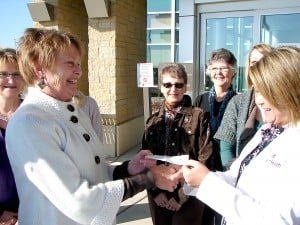 Two Orange County nurses seeded their dreams of a Rose Parade float to honor their profession with donations as small as a dollar.
Two Orange County nurses seeded their dreams of a Rose Parade float to honor their profession with donations as small as a dollar.
Pat Spongberg, 79, of Mission Viejo and Judy Dahle, 68, of Costa Mesa spent five years working to raise money for a nature-themed float designed to embody the healing traits of nurses.
The women are among five operating-room nurses who in 2007 formed a nonprofit, Bare Root Inc., that will present a one-time entry at Tuesday's parade in Pasadena.
"In our mind, that's how roses start – from a bare root," Spongberg said.
Click here to watch the nurses decorate their Rose Parade float.
Dahle added, "We were starting from a seed. We had some moments where we'd go, 'What are we doing?' We're finally in the blossoming stage."
The float, titled "A Healing Place," will carry 6,000 roses as well as 10 nurses and nursing students.
"The Rose Parade is seen by millions around the world," Dahle said. "It is an opportunity to showcase nursing internationally. The people that watch it, probably every one, have been touched by a nurse in one way or another."
GRASS-ROOTS START
The idea came about at an operating-room nursing conference where they learned that their colleague, Sally Bixby, would serve as president of the Tournament of Roses for the 2013 parade.
"I'm totally honored by it," said Bixby, who spent 38 years as a nurse. "I can't believe they did it. When they called me originally a few years ago to tell me they were going to take this on, it gave me chills."
In the beginning, fundraising went slowly. The board members started by seeking donations at nursing conferences.
"We'd literally have a little box out at the table, and people threw in $1 or $5 or maybe a 20," said Dahle, who is a consultant after years of working at Hoag Hospital.
The economy plunged into recession, and when pitching their project, 2013 sounded very far away to prospective donors.
Still, the group persisted, spending its own money to travel to conferences across the country.
Members created a website, where supporters could buy a rose to honor a nurse or make a credit card donation. Several hospitals gave the largest gifts of $30,000 each.
"I think we all feel a sense of pride of accomplishment," said Spongberg, who retired from Mission Hospital.
PAYING TRIBUTE
Hundreds of nurses have volunteered to decorate the float, which showcases animals that symbolize the traits of a good nurse. Three nightingales on a branch pay tribute to Florence Nightingale, the founder of modern nursing. Owls stand for wisdom. (Nightingale also had a pet owl.) The raccoon represents intelligence and the nurses who work all night. The mother deer symbolizes caring.
The lanterns are replicas of the kind Nightingale used to visit her patients at night.
"That was our one touch of sentimental nursing," Dahle said.
Words along the bottom include: compassionate, gentle, leader, conscientious and confident.
The 55-foot-long float cost $215,000. In all, the nurses raised $400,000. After accounting for other administrative and technical expenses, the nonprofit will donate the remaining funds for nursing scholarships and then dissolve.
"We don't have the fundraising background to go through it again," Dahle said. "People don't realize the business behind it."
Nurse Cherie Fox, 41, was scheduled to work in the cardiac intensive care unit at Mission Hospital on New Year's Day, but her plans changed after she was selected to ride on the float.
"I think it's amazing that they have taken it on to truly highlight the nursing profession," said Fox, who lives in Huntington Beach. "Most nurses go into nursing because they have a desire to give back and make connections with families and patients. Nurses learn to work in whatever they're put into. We all try to do it with grace and dignity."
Some nurses will travel from other states to attend the parade. Dahle last watched in person 40 years ago. Spongberg will attend the parade for the first time ever with her husband.
"I am very excited. This is the culmination of all we've worked for," Spongberg said. "To see the finished product going down Colorado Boulevard is going to be awesome."


 After much anticipation across the nation,
After much anticipation across the nation,  OWATONNA — A new program is now in place at Owatonna Hospital to help people who have been victims of sexual assault.
OWATONNA — A new program is now in place at Owatonna Hospital to help people who have been victims of sexual assault. A series of simple phone calls from a nurse can reduce readmissions and cut $1,225 in costs per patient, according to a
A series of simple phone calls from a nurse can reduce readmissions and cut $1,225 in costs per patient, according to a